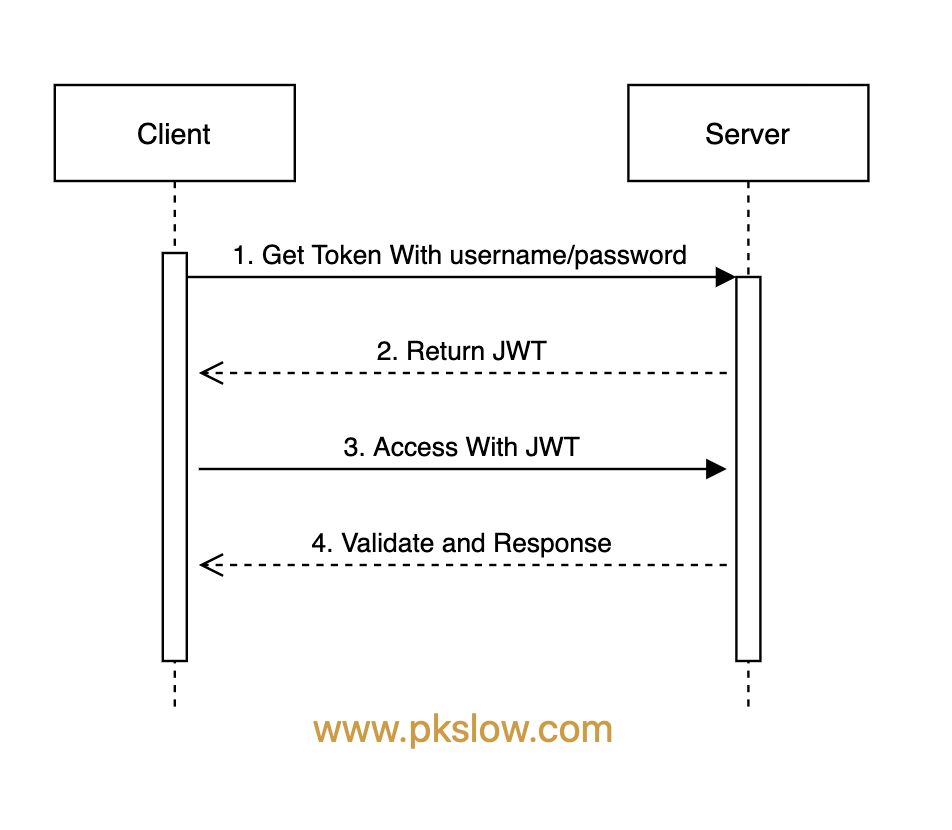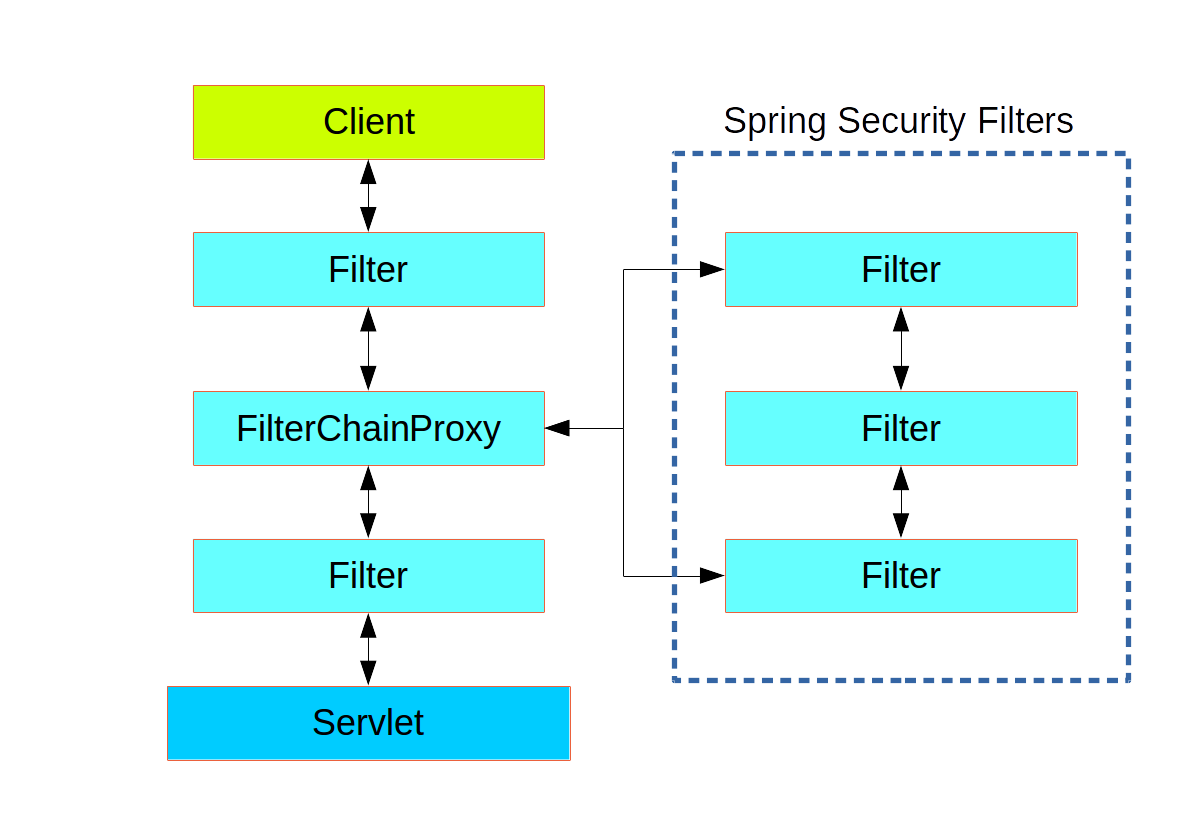我最新最全的文章都在 南瓜慢说 www.pkslow.com ,欢迎大家来喝茶!
Spring Security作为成熟且强大的安全框架,得到许多大厂的青睐。而作为前后端分离的SSO方案,JWT也在许多项目中应用。本文将介绍如何通过Spring Security实现JWT认证。
用户与服务器交互大概如下:

JWT,一般通过POST方法把用户名/密码传给server;JWT并返回;不正确则返回错误;JWT后,在有效期内都可以通过JWT来访问资源了,一般把JWT放在请求头;一次获取,多次使用;JWT是否合法,合法则允许客户端正常访问,不合法则返回401。我们把要整合的Spring Security和JWT加入到项目的依赖中去:
<dependency>
<groupId>org.springframework.boot</groupId>
<artifactId>spring-boot-starter-web</artifactId>
</dependency>
<dependency>
<groupId>org.springframework.boot</groupId>
<artifactId>spring-boot-starter-security</artifactId>
</dependency>
<dependency>
<groupId>io.jsonwebtoken</groupId>
<artifactId>jjwt</artifactId>
<version>0.9.1</version>
</dependency>
JWT工具类起码要具有以下功能:
具体代码如下:
@Component
public class JwtTokenProvider {
@Autowired JwtProperties jwtProperties;
@Autowired
private CustomUserDetailsService userDetailsService;
private String secretKey;
@PostConstruct
protected void init() {
secretKey = Base64.getEncoder().encodeToString(jwtProperties.getSecretKey().getBytes());
}
public String createToken(String username, List<String> roles) {
Claims claims = Jwts.claims().setSubject(username);
claims.put("roles", roles);
Date now = new Date();
Date validity = new Date(now.getTime() + jwtProperties.getValidityInMs());
return Jwts.builder()//
.setClaims(claims)//
.setIssuedAt(now)//
.setExpiration(validity)//
.signWith(SignatureAlgorithm.HS256, secretKey)//
.compact();
}
public Authentication getAuthentication(String token) {
UserDetails userDetails = this.userDetailsService.loadUserByUsername(getUsername(token));
return new UsernamePasswordAuthenticationToken(userDetails, "", userDetails.getAuthorities());
}
public String getUsername(String token) {
return Jwts.parser().setSigningKey(secretKey).parseClaimsJws(token).getBody().getSubject();
}
public String resolveToken(HttpServletRequest req) {
String bearerToken = req.getHeader("Authorization");
if (bearerToken != null && bearerToken.startsWith("Bearer ")) {
return bearerToken.substring(7);
}
return null;
}
public boolean validateToken(String token) {
try {
Jws<Claims> claims = Jwts.parser().setSigningKey(secretKey).parseClaimsJws(token);
if (claims.getBody().getExpiration().before(new Date())) {
return false;
}
return true;
} catch (JwtException | IllegalArgumentException e) {
throw new InvalidJwtAuthenticationException("Expired or invalid JWT token");
}
}
}
工具类还实现了另一个功能:从HTTP请求头中获取JWT。
Filter是Security处理的关键,基本上都是通过Filter来拦截请求的。首先从请求头取出JWT,然后校验JWT是否合法,如果合法则取出Authentication保存在SecurityContextHolder里。如果不合法,则做异常处理。
public class JwtTokenAuthenticationFilter extends GenericFilterBean {
private JwtTokenProvider jwtTokenProvider;
public JwtTokenAuthenticationFilter(JwtTokenProvider jwtTokenProvider) {
this.jwtTokenProvider = jwtTokenProvider;
}
@Override
public void doFilter(ServletRequest req, ServletResponse res, FilterChain filterChain)
throws IOException, ServletException {
HttpServletRequest request = (HttpServletRequest) req;
HttpServletResponse response = (HttpServletResponse) res;
try {
String token = jwtTokenProvider.resolveToken(request);
if (token != null && jwtTokenProvider.validateToken(token)) {
Authentication auth = jwtTokenProvider.getAuthentication(token);
if (auth != null) {
SecurityContextHolder.getContext().setAuthentication(auth);
}
}
} catch (InvalidJwtAuthenticationException e) {
response.setStatus(HttpStatus.UNAUTHORIZED.value());
response.getWriter().write("Invalid token");
response.getWriter().flush();
return;
}
filterChain.doFilter(req, res);
}
}
对于异常处理,使用@ControllerAdvice是不行的,应该这个是Filter,在这里抛的异常还没有到DispatcherServlet,无法处理。所以Filter要自己做异常处理:
catch (InvalidJwtAuthenticationException e) {
response.setStatus(HttpStatus.UNAUTHORIZED.value());
response.getWriter().write("Invalid token");
response.getWriter().flush();
return;
}
最后的return;不能省略,因为已经把要输出的内容给Response了,没有必要再往后传递,否则会报错:
java.lang.IllegalStateException: getWriter() has already been called
JWT需要配置一个密钥来加密,同时还要配置JWT令牌的有效期。
@Configuration
@ConfigurationProperties(prefix = "pkslow.jwt")
public class JwtProperties {
private String secretKey = "pkslow.key";
private long validityInMs = 3600_000;
//getter and setter
}
Spring Security的整个框架还是比较复杂的,简化后大概如下图所示:

它是通过一连串的Filter来进行安全管理。细节这里先不展开讲。
这个配置也可以理解为是FilterChain的配置,可以不用理解,代码很好懂它做了什么:
@Configuration
public class SecurityConfig extends WebSecurityConfigurerAdapter {
@Autowired
JwtTokenProvider jwtTokenProvider;
@Bean
@Override
public AuthenticationManager authenticationManagerBean() throws Exception {
return super.authenticationManagerBean();
}
@Bean
public PasswordEncoder passwordEncoder() {
return NoOpPasswordEncoder.getInstance();
}
@Override
protected void configure(HttpSecurity http) throws Exception {
http
.httpBasic().disable()
.csrf().disable()
.sessionManagement().sessionCreationPolicy(SessionCreationPolicy.STATELESS)
.and()
.authorizeRequests()
.antMatchers("/auth/login").permitAll()
.antMatchers(HttpMethod.GET, "/admin").hasRole("ADMIN")
.antMatchers(HttpMethod.GET, "/user").hasRole("USER")
.anyRequest().authenticated()
.and()
.apply(new JwtSecurityConfigurer(jwtTokenProvider));
}
}
这里通过HttpSecurity配置了哪些请求需要什么权限才可以访问。
/auth/login用于登陆获取JWT,所以都能访问;/admin只有ADMIN用户才可以访问;/user只有USER用户才可以访问。而之前实现的Filter则在下面配置使用:
public class JwtSecurityConfigurer extends SecurityConfigurerAdapter<DefaultSecurityFilterChain, HttpSecurity> {
private JwtTokenProvider jwtTokenProvider;
public JwtSecurityConfigurer(JwtTokenProvider jwtTokenProvider) {
this.jwtTokenProvider = jwtTokenProvider;
}
@Override
public void configure(HttpSecurity http) throws Exception {
JwtTokenAuthenticationFilter customFilter = new JwtTokenAuthenticationFilter(jwtTokenProvider);
http.exceptionHandling()
.authenticationEntryPoint(new JwtAuthenticationEntryPoint())
.and()
.addFilterBefore(customFilter, UsernamePasswordAuthenticationFilter.class);
}
}
通常在Spring Security的世界里,都是通过实现UserDetailsService来获取UserDetails的。
@Component
public class CustomUserDetailsService implements UserDetailsService {
private UserRepository users;
public CustomUserDetailsService(UserRepository users) {
this.users = users;
}
@Override
public UserDetails loadUserByUsername(String username) throws UsernameNotFoundException {
return this.users.findByUsername(username)
.orElseThrow(() -> new UsernameNotFoundException("Username: " + username + " not found"));
}
}
对于UserRepository,可以从数据库中读取,或者其它用户管理中心。为了方便,我使用Map放了两个用户:
@Repository
public class UserRepository {
private static final Map<String, User> allUsers = new HashMap<>();
@Autowired
private PasswordEncoder passwordEncoder;
@PostConstruct
protected void init() {
allUsers.put("pkslow", new User("pkslow", passwordEncoder.encode("123456"), Collections.singletonList("ROLE_ADMIN")));
allUsers.put("user", new User("user", passwordEncoder.encode("123456"), Collections.singletonList("ROLE_USER")));
}
public Optional<User> findByUsername(String username) {
return Optional.ofNullable(allUsers.get(username));
}
}
完成代码编写后,我们来测试一下:
(1)无JWT访问,失败
curl http://localhost:8080/admin
{"timestamp":"2021-02-06T05:45:06.385+0000","status":403,"error":"Forbidden","message":"Access Denied","path":"/admin"}
$ curl http://localhost:8080/user
{"timestamp":"2021-02-06T05:45:16.438+0000","status":403,"error":"Forbidden","message":"Access Denied","path":"/user"}
(2)admin获取JWT,密码错误则失败,密码正确则成功
$ curl http://localhost:8080/auth/login -X POST -d ‘{"username":"pkslow","password":"xxxxxx"}‘ -H ‘Content-Type: application/json‘
{"timestamp":"2021-02-06T05:47:16.254+0000","status":403,"error":"Forbidden","message":"Access Denied","path":"/auth/login"}
$ curl http://localhost:8080/auth/login -X POST -d ‘{"username":"pkslow","password":"123456"}‘ -H ‘Content-Type: application/json‘
eyJhbGciOiJIUzI1NiJ9.eyJzdWIiOiJwa3Nsb3ciLCJyb2xlcyI6WyJST0xFX0FETUlOIl0sImlhdCI6MTYxMjU5MDYxNCwiZXhwIjoxNjEyNTkxMjE0fQ.d4Gi50aaOsHHqpM0d8Mh1960otnZf7rlE3x6xSfakVo
(3)admin带JWT访问/admin,成功;访问/user失败
$ curl http://localhost:8080/admin -H ‘Authorization: Bearer eyJhbGciOiJIUzI1NiJ9.eyJzdWIiOiJwa3Nsb3ciLCJyb2xlcyI6WyJST0xFX0FETUlOIl0sImlhdCI6MTYxMjU5MDYxNCwiZXhwIjoxNjEyNTkxMjE0fQ.d4Gi50aaOsHHqpM0d8Mh1960otnZf7rlE3x6xSfakVo‘
you are admin
$ curl http://localhost:8080/user -H ‘Authorization: Bearer eyJhbGciOiJIUzI1NiJ9.eyJzdWIiOiJwa3Nsb3ciLCJyb2xlcyI6WyJST0xFX0FETUlOIl0sImlhdCI6MTYxMjU5MDYxNCwiZXhwIjoxNjEyNTkxMjE0fQ.d4Gi50aaOsHHqpM0d8Mh1960otnZf7rlE3x6xSfakVo‘
{"timestamp":"2021-02-06T05:51:23.099+0000","status":403,"error":"Forbidden","message":"Forbidden","path":"/user"}
(4)使用过期的JWT访问,失败
$ curl http://localhost:8080/admin -H ‘Authorization: Bearer eyJhbGciOiJIUzI1NiJ9.eyJzdWIiOiJwa3Nsb3ciLCJyb2xlcyI6WyJST0xFX0FETUlOIl0sImlhdCI6MTYxMjU5MDQ0OSwiZXhwIjoxNjEyNTkwNTA5fQ.CSaubE4iJcYATbLmbb59aNFU1jNCwDFHUV3zIakPU64‘
Invalid token
对于用户user同样可以测试,这里不列出来了。
代码请查看:https://github.com/LarryDpk/pkslow-samples
欢迎关注微信公众号<南瓜慢说>,将持续为你更新...

多读书,多分享;多写作,多整理。
Springboot集成Spring Security实现JWT认证
原文:https://www.cnblogs.com/larrydpk/p/14939748.html